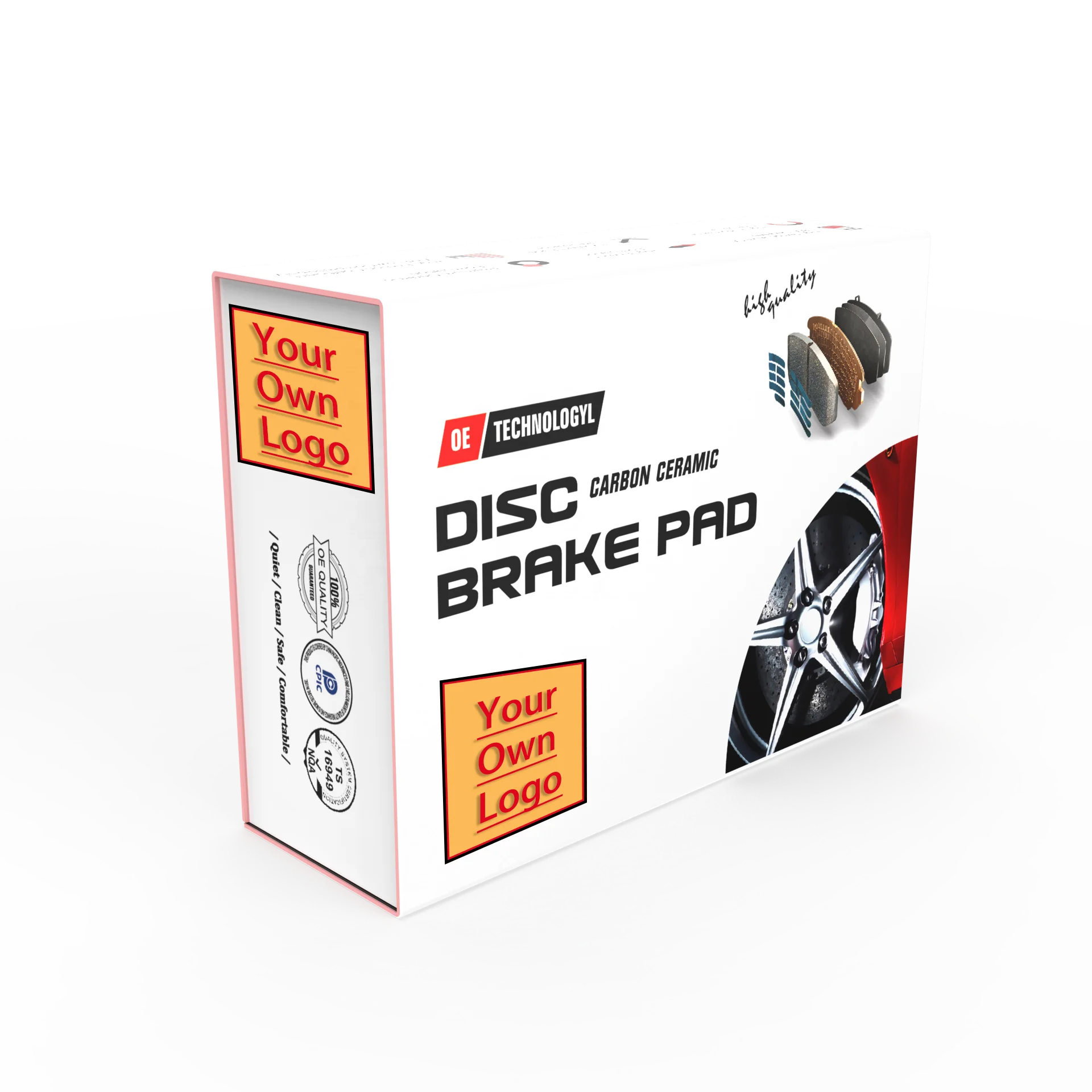Selecting the right automotive brake pads represents one of the most critical safety decisions vehicle owners face today. With countless options flooding the market and varying performance characteristics across different materials and designs, making an informed choice requires understanding the fundamental principles that govern braking systems. Modern automotive brake pads have evolved significantly from their early counterparts, incorporating advanced materials and engineering techniques that deliver superior stopping power, reduced noise, and extended service life. The importance of this decision extends far beyond simple cost considerations, as the wrong choice can compromise vehicle safety, increase maintenance costs, and lead to premature component failure throughout the entire braking system.

Understanding Brake Pad Materials and Technologies
Ceramic Brake Pad Composition
Ceramic automotive brake pads represent the premium segment of friction materials, utilizing a sophisticated blend of ceramic fibers, nonferrous filler materials, and advanced binding agents. These components work synergistically to create exceptional heat dissipation characteristics while maintaining consistent friction coefficients across varying temperature ranges. The ceramic matrix provides superior dimensional stability under extreme thermal stress, preventing the warping and degradation commonly associated with inferior materials. Manufacturing processes involve precise temperature control during curing phases, ensuring optimal molecular bonding between ceramic particles and reinforcing fibers.
The advantages of ceramic formulations extend beyond basic performance metrics to encompass environmental considerations and long-term cost effectiveness. These pads generate significantly less brake dust compared to metallic alternatives, preserving wheel appearance and reducing environmental contamination. Additionally, ceramic automotive brake pads operate with reduced noise generation, eliminating the squealing and grinding sounds that plague lower-quality alternatives. The superior wear characteristics of ceramic materials translate into extended service intervals, often doubling the lifespan of conventional organic pads while maintaining consistent performance throughout their operational life.
Semi-Metallic Brake Pad Engineering
Semi-metallic brake pad technology incorporates metallic fibers and particles within an organic matrix, creating a hybrid solution that balances performance with cost considerations. These formulations typically contain steel wool, copper fibers, and other metallic components that enhance thermal conductivity and provide aggressive initial bite characteristics. The metallic content ranges from thirty to sixty percent, with higher concentrations delivering improved heat dissipation but potentially increasing rotor wear rates. Manufacturing precision becomes critical in achieving optimal metallic particle distribution throughout the friction material matrix.
Performance characteristics of semi-metallic automotive brake pads make them particularly suitable for high-performance applications and heavy-duty vehicles requiring maximum stopping power. The enhanced thermal conductivity allows these pads to maintain effectiveness under severe braking conditions, making them ideal for mountainous terrain or frequent stop-and-go traffic scenarios. However, the metallic content can result in increased brake dust production and potential noise issues, requiring careful consideration of application requirements. The aggressive nature of semi-metallic formulations may accelerate rotor wear, necessitating more frequent inspection and potential replacement of associated components.
Vehicle-Specific Selection Criteria
OEM Specifications and Compatibility
Original Equipment Manufacturer specifications provide the foundational framework for selecting appropriate automotive brake pads that maintain vehicle safety and performance standards. These specifications encompass dimensional tolerances, friction coefficients, thermal properties, and wear characteristics specifically engineered for individual vehicle platforms. Understanding OEM requirements involves analyzing technical documentation, service bulletins, and performance data that manufacturers provide to ensure optimal system integration. Deviation from these specifications can result in compromised braking performance, premature component wear, and potential safety hazards that may void vehicle warranties.
Compatibility considerations extend beyond simple dimensional matching to include brake system architecture, Electronic Stability Control integration, and Anti-lock Braking System functionality. Modern vehicles rely on sophisticated sensor networks that monitor brake pad thickness, temperature, and performance characteristics in real-time. Aftermarket automotive brake pads must maintain compatibility with these electronic systems while delivering performance characteristics that match or exceed OEM standards. The selection process requires careful evaluation of vehicle-specific requirements, including gross vehicle weight, typical driving conditions, and intended service applications.
Driving Conditions and Performance Requirements
Driving environment analysis represents a crucial factor in determining optimal brake pad selection, as different conditions impose varying demands on friction materials and thermal management systems. Urban driving characterized by frequent stops and moderate speeds requires automotive brake pads optimized for low-temperature effectiveness and minimal dust generation. Highway driving emphasizes fade resistance and consistent performance across extended temperature ranges, while mountainous terrain demands maximum heat dissipation capabilities and aggressive initial bite characteristics. Commercial and towing applications require heavy-duty formulations capable of managing extreme thermal loads and repeated severe braking cycles.
Performance requirements must align with realistic assessment of vehicle usage patterns and driver expectations regarding noise, dust, and service life. Enthusiast drivers prioritizing maximum stopping power may accept increased noise and dust generation in exchange for superior performance characteristics. Family vehicle applications typically prioritize quiet operation, minimal dust production, and extended service intervals over ultimate performance capabilities. Fleet operators focus on cost-effectiveness, predictable wear patterns, and compatibility with existing maintenance schedules when selecting automotive brake pads for commercial applications.
Installation and Maintenance Best Practices
Proper Installation Procedures
Correct installation procedures ensure optimal performance and longevity of automotive brake pads while maintaining system safety and reliability. Pre-installation inspection involves thorough examination of rotors, calipers, and associated hardware to identify wear patterns, damage, or contamination that could compromise pad performance. Rotor surface preparation may require machining or replacement to eliminate scoring, warping, or excessive wear that prevents proper pad contact. Hardware replacement, including clips, springs, and anti-squeal shims, ensures proper pad positioning and reduces noise generation throughout the service life.
Installation torque specifications must be strictly observed to prevent uneven pad wear, noise issues, and potential safety hazards. Caliper piston retraction requires proper tools and techniques to avoid damage to seals and internal components. Break-in procedures involve gradual heating cycles that allow friction materials to conform to rotor surfaces and achieve optimal contact patterns. Proper bedding eliminates initial glazing tendencies and establishes the friction transfer layers essential for consistent performance. Documentation of installation procedures and component specifications facilitates future maintenance planning and warranty compliance.
Ongoing Maintenance and Inspection
Regular inspection protocols enable early detection of wear patterns, performance degradation, and potential system issues that could compromise safety or increase repair costs. Visual inspection should occur at regular service intervals, examining pad thickness, wear indicators, and surface conditions that indicate normal or abnormal operation. Measurement techniques using appropriate tools provide accurate assessment of remaining service life and help establish replacement schedules. Brake system performance monitoring includes pedal feel evaluation, stopping distance assessment, and noise analysis that can indicate developing problems.
Maintenance scheduling should align with manufacturer recommendations while considering actual driving conditions and usage patterns that may accelerate wear rates. Automotive brake pads operating in severe service applications require more frequent inspection and potential early replacement to maintain safety margins. Documentation of inspection findings, measurements, and maintenance actions creates valuable historical data for optimizing replacement intervals and identifying system trends. Proactive maintenance approaches prevent emergency failures, reduce total ownership costs, and ensure consistent vehicle safety performance throughout the service life.
Cost Analysis and Value Considerations
Initial Investment vs Long-Term Value
Cost analysis for automotive brake pads must encompass total ownership expenses rather than focusing solely on initial purchase prices. Premium pad formulations typically command higher upfront costs but deliver extended service life, reduced rotor wear, and minimal maintenance requirements that lower overall expenses. Calculation methodologies should include pad replacement costs, associated labor charges, rotor replacement frequency, and potential secondary component wear accelerated by inferior pad materials. Fleet operators and high-mileage drivers often achieve superior value through premium pad selection despite higher initial investments.
Value considerations extend beyond financial metrics to include safety, reliability, and convenience factors that impact total ownership experience. High-quality automotive brake pads provide consistent performance characteristics that enhance vehicle safety while reducing the frequency of service interruptions. Professional drivers and commercial operators benefit from predictable maintenance schedules and reduced downtime associated with premium friction materials. The selection decision should balance immediate budget constraints against long-term operational costs and reliability requirements specific to individual applications and usage patterns.
Market Comparison and Brand Evaluation
Market analysis reveals significant variation in automotive brake pads pricing, performance characteristics, and quality levels across different manufacturers and product lines. Established brands typically offer comprehensive product development, extensive testing protocols, and reliable warranty support that justify premium pricing structures. Budget alternatives may provide acceptable performance for specific applications but often lack the engineering sophistication and quality assurance associated with premium manufacturers. Comparative evaluation should consider technical specifications, user reviews, professional recommendations, and warranty terms when assessing value propositions.
Brand evaluation criteria should encompass manufacturing quality, research and development capabilities, customer support infrastructure, and market reputation established through years of performance data. Professional mechanics and automotive service providers often maintain preferred supplier relationships based on consistent product quality, technical support availability, and competitive pricing structures. Consumer feedback through online reviews, automotive forums, and professional publications provides valuable insight into real-world performance characteristics and reliability trends. The selection process benefits from comprehensive research that considers multiple information sources and aligns product capabilities with specific application requirements.
FAQ
What factors determine the ideal brake pad material for my vehicle
The ideal brake pad material depends on your vehicle specifications, driving conditions, and performance priorities. Ceramic automotive brake pads offer quiet operation, minimal dust, and excellent longevity for daily driving applications. Semi-metallic formulations provide superior heat dissipation and stopping power for performance vehicles or heavy-duty applications. Organic materials deliver cost-effective solutions for light-duty vehicles with moderate performance requirements. Consider your typical driving environment, vehicle weight, and desired service intervals when selecting appropriate friction materials.
How often should automotive brake pads be inspected and replaced
Inspection frequency should align with manufacturer recommendations, typically every 12,000 to 15,000 miles, while considering actual driving conditions that may accelerate wear rates. Replacement intervals vary significantly based on pad material, driving habits, vehicle weight, and environmental conditions, ranging from 25,000 to 70,000 miles. Severe service applications including frequent stop-and-go traffic, mountainous terrain, or heavy towing require more frequent inspection and potential early replacement. Monitor wear indicators, pad thickness measurements, and performance characteristics to establish optimal replacement schedules for your specific application.
Can mixing different brake pad brands or materials cause problems
Mixing different brake pad brands or materials between axles can create performance imbalances, uneven braking forces, and potential safety hazards. Front and rear axles require matched friction characteristics to maintain proper brake balance and prevent premature lockup or inadequate stopping power. Different materials exhibit varying friction coefficients, thermal properties, and wear characteristics that can compromise system integration. Always replace automotive brake pads in complete axle sets using identical materials and specifications to ensure optimal performance and safety.
What symptoms indicate that brake pads need immediate replacement
Critical symptoms requiring immediate attention include grinding noises indicating metal-to-metal contact, significantly reduced stopping power, pulsating brake pedal feel, or visible pad material below minimum thickness specifications. Warning indicator lights, squealing sounds from wear indicators, or brake fluid contamination also signal urgent replacement needs. Extended stopping distances, pulling to one side during braking, or unusual vibrations through the brake pedal indicate potential system problems requiring professional diagnosis. Never ignore these warning signs as continued operation can result in expensive rotor damage and compromised vehicle safety.

